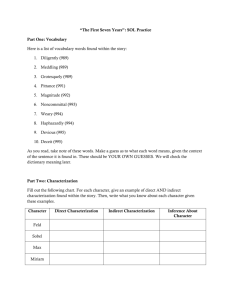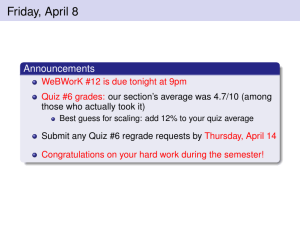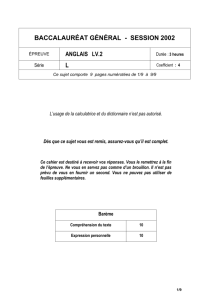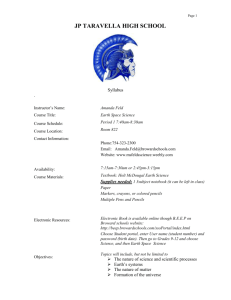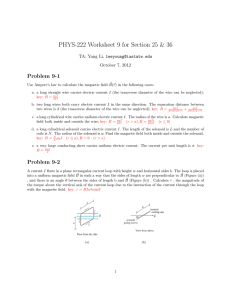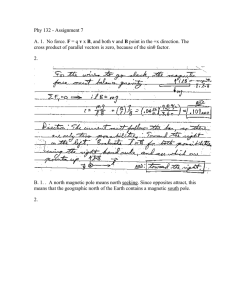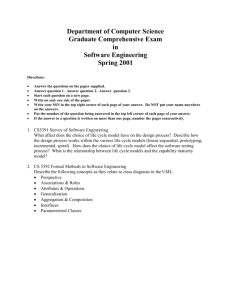Chapter 19
advertisement
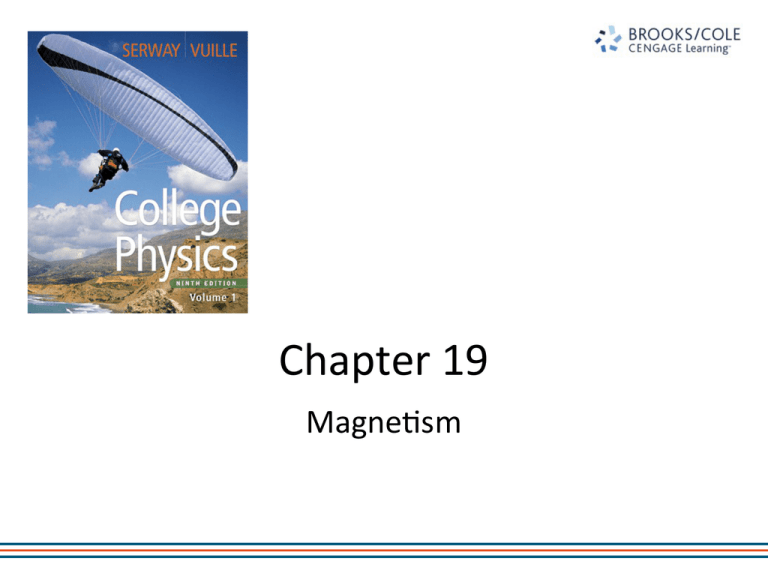
Chapter 19 Magnetsm Quiz 6. 1. The north-pole end of a bar magnet is held near a stationary positively charged piece of plastic. Is the plastic (a) attracted, (b) repelled, or (c) unaffected by the magnet? 2. Can a constant electric field change the speed of a moving charged particle? Can a constant magnetic field change the speed of a moving charged particle? Explain with necessary equations.. Quiz 7. 1. A square and a circular loop with the same area lie in the xy-plane, where there is a uniform magnetic field B pointing at some angle with respect to the positive z-direction. Each loop carries the same current, in the same direction. Which magnetic torque is larger? (a) the torque on the square loop (b) on the circular loop (c) the torques are the same (d) more info. is needed 2. The figure shows a current i through a wire in a uniform magnetic field , as well as the magnetic force acting on the wire. The field is oriented so that the force is maximum. In what direction is the field? 3. The figure here shows the circular paths of two particles that travel at the same speed in a uniform magnetic field , which is directed into the page. One particle is a proton; the other is an electron (which is less massive). (a) Which particle follows the smaller circle,and (b) does that particle travel clockwise or counterclockwise? Magnetsm •Magnetsm is one of the most important felds in physics in terms of applicatons. •Magnetsm is closely linked with electricity. –Magnetc felds afect moving charges. –Moving charges produce magnetc felds. –Changing magnetc felds can create electric felds. •James Clerk Maxwell frst described the underlying unity of electricity and magnetsm in the 19th century. Introducton Magnets •Poles of a magnet are the ends where objects are most strongly atracted. –Two poles, called north and south •Like poles repel each other and unlike poles atract each other. –Similar to electric charges •Magnetc poles cannot be isolated. –If a permanent magnetc is cut in half repeatedly, you will stll have a north and a south pole. –This difers from electric charges –There is some theoretcal basis for monopoles, but none have been detected. Secton 19.1 More About Magnetsm •An unmagnetzed piece of iron can be magnetzed by stroking it with a magnet. –Somewhat like stroking an object to charge it •Magnetsm can be induced. –If a piece of iron, for example, is placed near a strong permanent magnet, it will become magnetzed. Secton 19.1 Types of Magnetc Materials •Sof magnetc materials, such as iron, are easily magnetzed. –They also tend to lose their magnetsm easily. •Hard magnetc materials are difcult to magnetze. –They tend to retain their magnetsm. Secton 19.1 Sources of Magnetc Fields •The region of space surrounding a moving charge includes a magnetc feld. –The charge will also be surrounded by an electric feld. •A magnetc feld surrounds a properly magnetzed magnetc material. Secton 19.1 Magnetc Fields •A vector quantty •Symbolized by •Directon is given by the directon a north pole of a compass needle points in that locaton. •Magnetc feld lines can be used to show how the feld lines, as traced out by a compass, would look. Secton 19.1 Magnetc Field Lines, Sketch •A compass can be used to show the directon of the magnetc feld lines (a). •A sketch of the magnetc feld lines (b) Magnetc Field Lines, Bar Magnet •Iron flings are used to show the patern of the magnetc feld lines. •The directon of the feld is the directon a north pole would point. Magnetc Field Lines, Unlike Poles •Iron flings are used to show the patern of the magnetc feld lines. •The directon of the feld is the directon a north pole would point. –Compare to the electric feld produced by an electric dipole Magnetc Field Lines, Like Poles •Iron flings are used to show the patern of the electric feld lines. •The directon of the feld is the directon a north pole would point. –Compare to the electric feld produced by like charges Secton 19.1 Earth’s Magnetc Field •The Earth’s geographic north pole corresponds to a magnetc south pole. •The Earth’s geographic south pole corresponds to a magnetc north pole. –Strictly speaking, a north pole should be a “north-seeking” pole and a south pole a “southseeking” pole. – Secton 19.2 Earth’s Magnetc Field •The Earth’s magnetc feld resembles that achieved by burying a huge bar magnet deep in the Earth’s interior. Secton 19.2 The Geographic North Pole Is the magnetic South Pole The north pole of a magnet in a compass points north because it’s attracted to Earth’s magnetic south pole, located near Earth’s geographic north pole. Dip Angle of Earth’s Magnetc Field •If a compass is free to rotate vertcally as well as horizontally, it points to the earth’s surface. •The angle between the horizontal and the directon of the magnetc feld is called the dip angle. Secton 19.2 Dip Angle, Cont. •The farther north the device is moved, the farther from horizontal the compass needle would be. –The compass needle would be horizontal at the equator and the dip angle would be 0° –The compass needle would point straight down at the south magnetc pole and the dip angle would be 90° Secton 19.2 More About the Earth’s Magnetc Poles •The dip angle of 90° is found at a point just north of Hudson Bay in Canada. –This is considered to be the locaton of the south magnetc pole. •The magnetc and geographic poles are not in the same exact locaton. –The diference between true north, at the geographic north pole, and magnetc north is called the magnetc declinaton. •The amount of declinaton varies by locaton on the earth’s surface. • Secton 19.2 Earth’s Magnetc Declinaton Secton 19.2 Source of the Earth’s Magnetc Field •There cannot be large masses of permanently magnetzed materials since the high temperatures of the core prevent materials from retaining permanent magnetzaton. •The most likely source of the Earth’s magnetc feld is believed to be electric currents in the liquid part of the core. Secton 19.2 Reversals of the Earth’s Magnetc Field •The directon of the Earth’s magnetc feld reverses every few million years. –Evidence of these reversals are found in basalts resultng from volcanic actvity. –The origin of the reversals is not understood. Secton 19.2 Magnetc Fields •When a charged partcle is moving through a magnetc feld, a magnetc force acts on it. –This force has a maximum value when the charge moves perpendicularly to the magnetc feld lines. –This force is zero when the charge moves along the feld lines. Secton 19.3 Magnetc Fields, Cont. •One can defne a magnetc feld in terms of the magnetc force exerted on a test charge moving in the feld with velocity. –Similar to the way electric felds are defned –The magnitude of the magnetc force is F = q v B sin θ •This gives the magnitude of the magnetc feld as Secton 19.3 Units of Magnetc Field •The SI unit of magnetc feld is the Tesla (T) • • –Wb is a Weber •The cgs unit is a Gauss (G) –1 T = 104 G Secton 19.3 A Few Typical B Values •Conventonal laboratory magnets –25000 G or 2.5 T •Superconductng magnets –300000 G or 30 T •Earth’s magnetc feld –0.5 G or 5 x 10-5 T Secton 19.3 Finding the Directon of Magnetc Force •Experiments show that the directon of the magnetc force is always perpendicular to both and •Fmax occurs when the partcle’s moton is perpendicular to the feld. •F = 0 when the partcle’s moton is parallel to the feld. Secton 19.3 Right Hand Rule #1 •Point your fngers in the directon of the velocity. •Curl the fngers in the directon of the magnetc feld, •Your thumb points in the directon of the force on a positve charge. Secton 19.3 Force on a Negatve Charge •If the charge is negatve rather than positve, the force is directed opposite that obtained from the right-hand rule. Secton 19.3 Magnetc Force on a Current Carrying Conductor •A force is exerted on a current-carrying wire placed in a magnetc feld. –The current is a collecton of many charged partcles in moton. •The directon of the force is given by right hand rule #1. Secton 19.4 Secton 19.4 A proton moves with a speed of 1.00 x 105 m/s through Earth’s magnetic field, which has a value of 55.0 mT at a particular location. When the proton moves eastward, the magnetic force acting on it is directed straight upward, and when it moves northward, no magnetic force acts on it. (a) What is the direction of the magnetic field, and (b) what is the strength of the magnetic force when the proton moves eastward (a) Find the direction of the magnetic field. No magnetic force acts on the proton when it’s going north, so the angle such a proton makes with the magnetic field direction must be either 0° or 180°. Therefore, the magnetic field B must point either north or south. Now apply the righthand rule. When the particle travels east, Recalculate the forces when an electron travels the same manner with the same velocity. Force on a Wire •The green x’s indicate the magnetc feld is directed into the page. –The x represents the tail of the arrow. •Green dots would be used to represent the feld directed out of the page. –The • represents the head of the arrow. •In this case, there is no current, so there is no force. Secton 19.4 Force on a Wire, Cont. •B is into the page. •The current is up the page. •The force is to the lef. Secton 19.4 Force on a Wire,Final •B is into the page. •The current is down the page. •The force is to the right. Secton 19.4 Force on a Wire, Equaton •The magnetc force is exerted on each moving charge in the wire. •The total force is the sum of all the magnetc forces on all the individual charges producing the current. •F = B I ℓ sin θ –θ is the angle between and the directon of I –The directon is found by the right hand rule, placing your fngers in the directon of I instead of Secton 19.4 A proton moves at 8.00 x 106 m/s along the x-axis. It enters a region in which there is a magnetic field of magnitude 2.50 T, directed at an angle of 60.0° with the x-axis and lying in the xy-plane (Fig. 19.8). (a) Find the initial magnitude and direction of the magnetic force on the proton. (b) Calculate the proton’s initial acceleration. In a lightning strike there is a rapid movement of negative charge from a cloud to the ground. In what direction is a lightning strike deflected by Earth’s magnetic field? Torque on a Current Loop • = B I A N sin –Applies to any shape loop –N is the number of turns in the coil –Torque has a maximum value of NBIA •When = 90° –Torque is zero when the feld is parallel to the plane of the loop. Secton 19.5 Magnetc Moment •The vector is called the magnetc moment of the coil •Its magnitude is given by = IAN •The vector always points perpendicular to the plane of the loop(s). •The angle is between the moment and the feld. •The equaton for the magnetc torque can be writen as = B sin Secton 19.5 Electric Motor •An electric motor converts electrical energy to mechanical energy. –The mechanical energy is in the form of rotatonal kinetc energy. Secton 19.5 Electric Motor, 2 •An electric motor consists of a rigid current-carrying loop that rotates when placed in a magnetc feld. •The torque actng on the loop will tend to rotate the loop to smaller values of θ untl the torque becomes 0 at θ = 0° •If the loop turns past this point and the current remains in the same directon, the torque reverses and turns the loop in the opposite directon. Secton 19.5 Electric Motor, 3 •To provide contnuous rotaton in one directon, the current in the loop must periodically reverse. –In ac motors, this reversal naturally occurs. –In dc motors, a split-ring commutator and brushes are used. •Actual motors would contain many current loops and commutators. Secton 19.5 Electric Motor, Final •Just as the loop becomes perpendicular to the magnetc feld and the torque becomes 0, inerta carries the loop forward and the brushes cross the gaps in the ring, causing the current loop to reverse its directon. –This provides more torque to contnue the rotaton. –The process repeats itself. Secton 19.5 A circular wire loop of radius 1.00 m is placed in a magnetic field of magnitude 0.500 T. The normal to the plane of the loop makes an angle of 30.0° with the magnetic field (Fig. 19.16a). The current in the loop is 2.00 A in the direction shown. (a) Find the magnetic moment of the loop and the magnitude of the torque at this instant. (b) The same current is carried by the rectangular 2.00-m by 3.00-m coil with three loops shown in Figure 19.16b. Find the magnetic moment of the coil and the magnitude of the torque acting on the coil at that instant. Force on a Charged Partcle in a Magnetc Field •Consider a partcle moving in an external magnetc feld so that its velocity is perpendicular to the feld. •The force is always directed toward the center of the circular path. •The magnetc force causes a centripetal acceleraton, changing the directon of the velocity of the partcle. Secton 19.6 Force on a Charged Partcle •Equatng the magnetc and centripetal forces: • • •Solving for r: • • –r is proportonal to the momentum of the partcle and inversely proportonal to the magnetc feld. –Sometmes called the cyclotron equaton Secton 19.6 Partcle Moving in an External Magnetc Field •If the partcle’s velocity is not perpendicular to the feld, the path followed by the partcle is a spiral. –The spiral path is called a helix. Secton 19.6 Hans Christan Oersted •1777 – 1851 •Best known for observing that a compass needle defects when placed near a wire carrying a current –First evidence of a connecton between electric and magnetc phenomena Secton 19.7 Magnetc Fields – Long Straight Wire •A current-carrying wire produces a magnetc feld. •The compass needle defects in directons tangent to the circle. –The compass needle points in the directon of the magnetc feld produced by the current. Secton 19.7 Directon of the Field of a Long Straight Wire •Right Hand Rule #2 –Grasp the wire in your right hand. –Point your thumb in the directon of the current. –Your fngers will curl in the directon of the feld. Secton 19.7 Magnitude of the Field of a Long Straight Wire •The magnitude of the feld at a distance r from a wire carrying a current of I is • • •µo = 4 x 10-7 T.m / A –µo is called the permeability of free space Secton 19.7 André-Marie Ampère •1775 – 1836 •Credited with the discovery of electromagnetsm –Relatonship between electric currents and magnetc felds Secton 19.7 Ampère’s Law •Ampère found a procedure for deriving the relatonship between the current in an arbitrarily shaped wire and the magnetc feld produced by the wire. •Ampère’s Circuital Law – B|| Δℓ = µo I –Sum over the closed path – Secton 19.7 Ampère’s Law to Find B for a Long Straight Wire •Use a closed circular path. •The circumference of the circle is 2 r • • • –This is identcal to the result previously obtained. Secton 19.7 Ampère’s Law, Cont. •Choose an arbitrary closed path around the current. •Sum all the products of B|| Δℓ around the closed path. Secton 19.7 B|| Δℓ = µo I Magnetc Force Between Two Parallel Conductors •The force on wire 1 is due to the current in wire 1 and the magnetc feld produced by wire 2. •The force per unit length is: • Secton 19.8 Force Between Two Conductors, Cont. •Parallel conductors carrying currents in the same directon atract each other. •Parallel conductors carrying currents in the opposite directons repel each other. • Secton 19.8 Defning Ampere and Coulomb •The force between parallel conductors can be used to defne the Ampere (A). –If two long, parallel wires 1 m apart carry the same current, and the magnitude of the magnetc force per unit length is 2 x 10-7 N/m, then the current is defned to be 1 A. •The SI unit of charge, the Coulomb (C), can be defned in terms of the Ampere. –If a conductor carries a steady current of 1 A, then the quantty of charge that fows through any cross secton in 1 second is 1 C. Secton 19.8 PROBLEM Two wires, each having a weight per unit length of 1.00 x 10-4 N/m, are parallel with one directly above the other. Assume the wires carry currents that are equal in magnitude and opposite in direction. The wires are 0.10 m apart, and the sum of the magnetic force and gravitational force on the upper wire is zero. Find the current in the wires. (Neglect Earth’s magnetic field.) Magnetc Field of a Current Loop •The strength of a magnetc feld produced by a wire can be enhanced by forming the wire into a loop. •All the segments, Δx, contribute to the feld, increasing its strength. Secton 19.9 Magnetc Field of a Current Loop •The magnetc feld lines for a current loop resemble those of a bar magnet. •One side of the loop acts as a north pole and the other side acts as a south pole. Secton 19.9 Magnetc Field of a Current Loop – Equaton •The magnitude of the magnetc feld at the center of a circular loop with a radius R and carrying current I is • • •With N loops in the coil, this becomes Secton 19.9 Magnetc Field of a Solenoid •If a long straight wire is bent into a coil of several closely spaced loops, the resultng device is called a solenoid. •It is also known as an electromagnet since it acts like a magnet only when it carries a current. Secton 19.9 Magnetc Field of a Solenoid, 2 •The feld lines inside the solenoid are nearly parallel, uniformly spaced, and close together. –This indicates that the feld inside the solenoid is strong and nearly uniform. •The exterior feld is nonuniform, much weaker than the interior feld, and in the opposite directon to the feld inside the solenoid. Secton 19.9 Magnetc Field in a Solenoid, 3 •The feld lines of a closely spaced solenoid resemble those of a bar magnet. •One end of the solenoid acts as a north pole and the other end as a south pole. • Magnetc Field in a Solenoid, Magnitude •The magnitude of the feld inside a solenoid is constant at all points far from its ends. •B = µo n I –n is the number of turns per unit length –n = N / ℓ •The same result can be obtained by applying Ampère’s Law to the solenoid. Secton 19.9 Magnetc Field in a Solenoid from Ampère’s Law •A cross-sectonal view of a tghtly wound solenoid •If the solenoid is long compared to its radius, we assume the feld inside is uniform and outside is zero. •Apply Ampère’s Law to the blue dashed rectangle. •Gives same result as previously found Secton 19.9 Magnetc Efects of Electrons – Orbits •An individual atom should act like a magnet because of the moton of the electrons about the nucleus. –Each electron circles the atom once in about every 10-16 seconds. –This would produce a current of 1.6 mA and a magnetc feld of about 20 T at the center of the circular path. •However, the magnetc feld produced by one electron in an atom is ofen canceled by an oppositely revolving electron in the same atom. Secton 19.10 Magnetc Efects of Electrons – Orbits, Cont. •The net result is that the magnetc efect produced by electrons orbitng the nucleus is either zero or very small for most materials. Secton 19.10 Magnetc Efects of Electrons – Spins •Electrons also have spin. –The classical model is to consider the electrons to spin like tops. –It is actually a quantum efect Secton 19.10 Magnetc Efects of Electrons – Spins, Cont. •The feld due to the spinning is generally stronger than the feld due to the orbital moton. •Electrons usually pair up with their spins opposite each other, so their felds cancel each other. –That is why most materials are not naturally magnetc. Secton 19.10 Magnetc Efects of Electrons – Domains •In some materials, the spins do not naturally cancel. –Such materials are called ferromagnetc •Large groups of atoms in which the spins are aligned are called domains. •When an external feld is applied, the domains that are aligned with the feld tend to grow at the expense of the others. –This causes the material to become magnetzed. Secton 19.10 Domains, Cont. •Random alignment (a) shows an unmagnetzed material. •When an external feld is applied, the domains aligned with B grow (b) and those not aligned become small (c ). Secton 19.10 Domains and Permanent Magnets •In hard magnetc materials, the domains remain aligned afer the external feld is removed. –The result is a permanent magnet. •In sof magnetc materials, once the external feld is removed, thermal agitaton causes the materials to quickly return to an unmagnetzed state. •With a core in a loop, the magnetc feld is enhanced since the domains in the core material align, increasing the magnetc feld. Secton 19.10 Types of Magnetc Materials •Ferromagnetc –Have permanent magnetc moments that align readily with an externally applied magnetc feld •Paramagnetc –Have magnetc moments that tend to align with an externally applied magnetc feld, but the response is weak compared to a ferromagnetc material •Diamagnetc –An externally applied feld induces a very weak magnetzaton that is opposite the directon of the applied feld.
